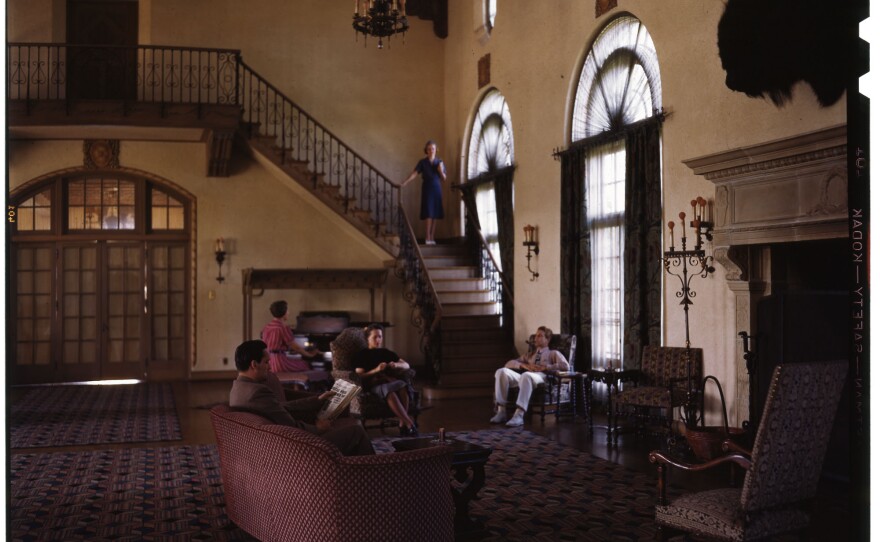On Aug. 25, The National Parks Service celebrated its 107th birthday. Since its founding in 1916, the National Park System has grown to more than 400 national parks and has drawn countless visitors. During the initial stages of the parks being founded, most people in the country couldn’t get to them without taking a train at least part of the way.
While neither Milwaukee or Wisconsin has a national park, we did have a role in driving some tourism out West. The Milwaukee Road was a local railroad company, who like many others at the time, tried to monopolize on the increased travel to national parks.
For August’s Book of the Month series with the Milwaukee Public Library, we’re exploring some of the Milwaukee Road Archives. Special collections librarian Greg Comly works primarily with the collection, which was donated to the Milwaukee Public Library directly from the Milwaukee Road in 1981.
"Their idea before they went bankrupt was [to] have a place to preserve all of their historical materials, so it is by far one of our biggest collections," notes Comly. "There's well over 50,000 engineering/architectural drawings, 18,000-plus photographs, and enough boxes to fill your grandmother's house."

Comly says that railroads have always had a unique relationship with the national parks long before the National Parks Service was even founded. For example, Yellowstone National Park had five railroads that connected to its boarders, including one from the Milwaukee Road.
"We see this all across the country where railroads are capitalizing on their closeness to national parks and they use it as a way not only to drum up passenger traffic because they care about the bottom dollar, but they also have this unique relationship with national parks on both promoting them and actively encouraging the public to use them," Comly explains.
The Milwaukee Road's first line was from Milwaukee to Waukesha in 1850, three years after the Milwaukee and Waukesha Railroad was incorporated. Around 27 passenger trains went through Milwaukee a day during this time, according to Comly, and as the company grew, the name changed with it.
In 1874 the name changed to Chicago, Milwaukee & St. Paul. When the company later completed a Pacific line, they became the Chicago, Milwaukee, St. Paul & Pacific. "[It's] a really big mouthful, so everyone calls it the 'Milwaukee Road,' which was never its official name," Comly says.
If you were making your way out to Yellowstone around 1926 from anywhere on the Milwaukee Road line, you'd take the Olympian or Columbian passenger trains and stop at Three Forks, Mont., according to Comly. From there you'd get on a station wagon and travel the nearly 100 miles to the Yellowstone Park border.
The Milwaukee Road built its own entrance, or gateway, to the park and built its own archway with towering trees from the West Coast. Once you arrived in the park, you'd get on a Yellowstone Park bus for a tour and then take a train back home. Since it took such a long time to travel to Yellowstone and explore the park, Milwaukee Road followed other railroad companies' strategy of building their own hotel.
"The Milwaukee Road was at a disadvantage to begin with because they were so far from the park. So what they decided to do was build a very nice luxurious hotel that was in a town called Salesville, which later changed its name to the Gallatin Gateway," says Comly.
The Gallatin Gateway Inn was a Spanish revival hotel that was one of the more luxurious railroad hotels of the time and was built in only four months, according to Comly. Completed in 1927, the Gallatin Gateway had a huge dining room that sat 350, a ballroom for hundreds to dance in, but only 27 rooms for people to stay in.
"This is because the Olympian and the Columbian passenger trains were overnight trains ... so you would either arrive in the morning and then you would have lunch and then you would go on your tour of Yellowstone, or you'd ride in the afternoon. You didn't really have to stay there," he notes.
While Comly says the Milwaukee Road did a lot of great things, they were often the last company to accomplish what other railroads were already doing. They were the last company to finish a transcontinental route, and the last company to establish a route in Yellowstone. "And it actually never did that well," he adds.
In 1925 there was up to 45,000 people arriving to Yellowstone by rail, but "a fraction of these were [from the] Milwaukee Road," says Comly. "Because the other railroads had such a better position, you know like West Yellowstone is 18 miles from the border of Yellowstone National Park. So they tried to capitalize. It didn't work out, but the hotel is still there so at least we got this nice bit of history that's still there."
Despite the struggles in expansion for the Milwaukee Road, Comly says what made it such a fantastic railroad was its innovation. At points in its service the company claimed to have the best passenger service and developed its own roller bearings in the trucks the cars sat on that made for an extremely smooth ride up to 100-plus miles per hour. It's electrified line out West was also a major accomplishment and huge undertaking.
"When it was built and for some time after, [Milwaukee Road had] the longest electrified route through the mountains," says Comly. "Electricity played a huge role — it allowed the railroad to reduce operating costs, but you also have these nice electric engines that don't throw off ash and steam and dust and were much quieter than our steam locomotive. So it was really innovative in how it did that."
_



















